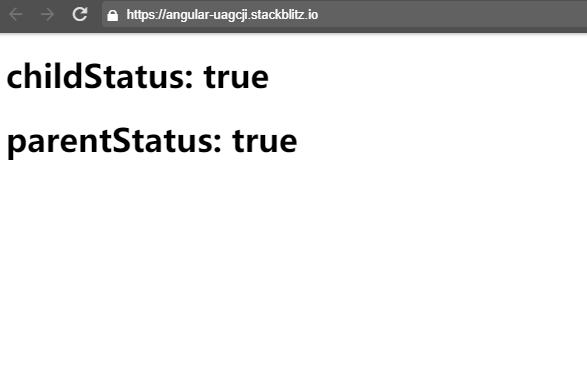下面小编就为大家分享一篇angular自定义组件实现数据双向数据绑定的实例,具有很好的参考价值,希望对大家有所帮助。一起跟随小编过来看看吧
学过Angular的同学都知道,输入框通过<span style="font-family:NSimsun">[(ngModel)]</span>实现双向数据绑定,那么自定义组件能不能实现双向数据绑定呢?答案是肯定的。
Angular中,我们常常需要通过方括号<span style="font-family:NSimsun">[]</span>和圆括号<span style="font-family:NSimsun">()</span>实现组件间的交互:

那么在<span style="font-family:NSimsun">[]</span>和<span style="font-family:NSimsun">()</span>的基础上,如何实现组件的双向数据绑定?
例子如下。
子组件:
<!--testDataBinding.component.html-->
<h1>childStatus: {{childStatus}}</h1>//testDataBinding.component.ts
export class TestDataBindingComponent implements OnInit{
@Input() childStatus;
@Output() childStatusChange = new EventEmitter();
ngOnInit(){
setTimeout(()=>{
this.childStatus = false;
this.childStatusChange.emit(this.childStatus);
},5000);
}
}注意这里的写法,这是关键所在,输出属性前半部分必须与输入属性相同,输入属性可以随意取名,输出属性需在输入属性基础上加上Change,比如你的输入属性是myData,那么输出属性就必须是myDataChange。
父组件:
<!--app.component.html-->
<test-binding [(childStatus)]="parentStatus"></test-binding>
<h1>parentStatus: {{parentStatus}}</h1>//app.component.ts
import { Component,OnInit } from '@angular/core';
@Component({
selector: 'my-app',
templateUrl: './app.component.html',
styleUrls: ['./app.component.css']
})
export class AppComponent implements OnInit{
parentStatus: boolean = true;
ngOnInit(){
setTimeout(()=>{
this.parentStatus = true;
},10000);
}
}在父组件我们初始化<span style="font-family:NSimsun">parentStatus</span>为<span style="font-family:NSimsun">true</span>,并把它传到子组件<span style="font-family:NSimsun">TestDataBindingComponent</span>。
在子组件里,5秒后我们把<span style="font-family:NSimsun">childStatus</span>设为<span style="font-family:NSimsun">false</span>,看它能不能传到父组件。再过5秒,我们在父组件将<span style="font-family:NSimsun">parentStatus</span>设为<span style="font-family:NSimsun">true</span>,看它能不能传到子组件。

事实证明,子组件值变化后,父组件的值也跟着变化;父组件值变化后子组件的值也跟着变了!
我们实现了双向绑定!
上面是我整理给大家的,希望今后会对大家有帮助。
相关文章:
以上就是在Angular中如何实现双向数据绑定的详细内容,更多请关注php中文网其它相关文章!

每个人都需要一台速度更快、更稳定的 PC。随着时间的推移,垃圾文件、旧注册表数据和不必要的后台进程会占用资源并降低性能。幸运的是,许多工具可以让 Windows 保持平稳运行。

Copyright 2014-2025 https://www.php.cn/ All Rights Reserved | php.cn | 湘ICP备2023035733号